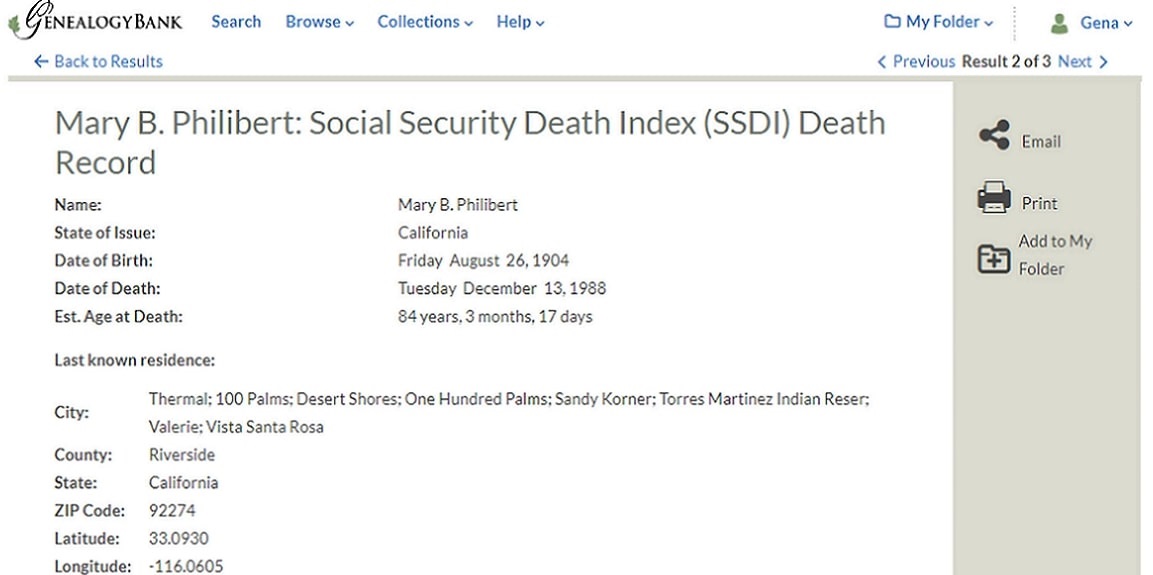Introduction: In this article – part of an ongoing “Introduction to Genealogy” series – Gena Philibert-Ortega describes an important resource for family historians: the Social Security Death Index. Gena is a genealogist and author of the book “From the Family Kitchen.”
The Social Security Death Index (SSDI) is one of those go-to resources for family historians researching American 20th century family members. Why? Because in the absence of a death date or place, it can provide you valuable clues about your ancestor.
The Social Security Death Index is one of the resources offered on GenealogyBank.
But before you use the SSDI, there are a few things to keep in mind.
The Social Security Death Index
In order to understand the Social Security Death Index, it’s helpful to know a few things about Social Security and the Death Index. The Social Security Act was enacted in 1935. The Social Security Death Index comes from the Social Security Administration’s Death Master Index.

But it’s important to know that just because the Social Security Act passed in 1935, that doesn’t mean you’ll find an ancestor who died shortly after the Act’s passage. The Social Security Death Index actually has very few deaths prior to 1962. And remember that these are deaths that were reported to Social Security.* It is NOT a national index of every adult who died.
The SSDI is an index – that means it does have its limitations. An index is not an original record, and there can be errors. For example, even though the SSDI provides a birth date, you shouldn’t rely only on that record for confirmation of your ancestor’s birth. You should seek out, when possible, original records that provide birth information, such as a birth certificate.
Whether the complete date of death is provided in the SSDI, or just the month and year, you should also seek out the death certificate for confirmation of the actual death date and place.
The places listed on the SSDI are also simply clues. The State of Issue is the state where your ancestor applied for their Social Security Number, which is not necessarily where they were born or where they lived for a long period of time. Similarly, the Last Known Residence provided in the SSDI does not necessarily equal the city where the person died. Remember that they could have died in a hospital in a neighboring town, while traveling, or at a family member’s house. The Last Known Residence simply provides you with a place where they lived – a valuable clue that may lead to other records.
Another limitation to the SSDI is the privacy restrictions enacted on it, which mean that the Index no longer includes the most recent deaths.
Searching the SSDI on GenealogyBank
The benefit of using GenealogyBank’s SSDI database is that you can use the clues it provides to continue searching on GenealogyBank’s other resources, such as the Historical Newspaper Archives, Obituaries Collection, U.S. Census Records, and Government Records. You can search these resources individually, or search on everything at once from GenealogyBank’s Home Page.
If you want to begin with just the Social Security Death Index, go directly to the SSDI page on GenealogyBank. That web page’s search engine allows you to add additional search terms in addition to a name or a death date, including the person’s last known residence, Social Security Number, and/or birth date.
As with any search, don’t fill every box in the search engine at first – better to begin with a broader search. If you receive too many results from that initial search, you can narrow your search by adding keywords or filling in some of the other boxes on the search engine.
Here is the Social Security Death Index record for my paternal great-grandmother Mary B. Chatham Philibert.
This record provides an exact date of birth and death. The “last known residence” information is confusing, listing various city names. However, if I didn’t know where she lived or where she died, I could use the county and state and start there in my search for that information.
Getting Started with the SSDI
You can learn more about the SSDI, including additional search tips, on the GenealogyBank Social Security Death Index page itself. Just click on the link, then scroll down past the search form for more SSDI information.
Explore over 330 years of newspapers and historical records in GenealogyBank. Discover your family story! Start a 7-Day Free Trial
* “The Social Security Death Index,” Online Death Indexes and Records (https://www.deathindexes.com/ssdi.html: accessed 16 January 2020).


My great grand-aunt Margaret left Ireland in 1921, and she is listed on the emigration documents under her maiden name. I have had no luck tracing her after the address in New York she stayed at when she arrived initially. Margaret may have gotten married. Have you any idea how to trace someone by their maiden name?